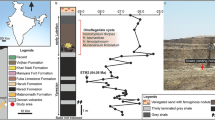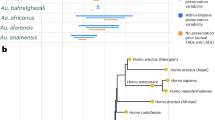Abstract
The earliest evolution of mammals and origins of mammalian features can be traced to the mammaliaforms of the Triassic and Jurassic periods that are extinct relatives to living mammals. Here we describe a new fossil from the Middle Jurassic that has a mandibular middle ear, a gradational transition of thoracolumbar vertebrae and primitive ankle features, but highly derived molars with a high crown and multiple roots that are partially fused. The upper molars have longitudinal cusp rows that occlude alternately with those of the lower molars. This specialization for masticating plants indicates that herbivory evolved among mammaliaforms, before the rise of crown mammals. The new species shares the distinctive dental features of the eleutherodontid clade, previously represented only by isolated teeth despite its extensive geographic distribution during the Jurassic. This eleutherodontid was terrestrial and had ambulatory gaits, analogous to extant terrestrial mammals such as armadillos or rock hyrax. Its fur corroborates that mammalian integument had originated well before the common ancestor of living mammals.
This is a preview of subscription content, access via your institution
Access options
Subscribe to this journal
Receive 51 print issues and online access
$199.00 per year
only $3.90 per issue
Buy this article
- Purchase on Springer Link
- Instant access to full article PDF
Prices may be subject to local taxes which are calculated during checkout




Similar content being viewed by others
References
Rowe, T. B. Definition, diagnosis, and origin of Mammalia. J. Vertebr. Paleontol. 8, 241–264 (1988)
Kermack, K. A., Kermack, D. M., Ires, P. M. & Mills, J. New multituberculate-like teeth from the Middle Jurassic of England. Acta Palaeontol. Pol. 43, 581–606 (1998)
Kielan-Jaworowska, Z., Cifelli, R. L. & Luo, Z.-X. Mammals from the Age of Dinosaurs: Origins, Evolution, and Structure (Columbia Univ. Press, 2004)
Liu, Y.-Q. et al. U-Pb zircon age for the Daohugou Biota at Ningcheng of Inner Mongolia and comments on related issues. Chin. Sci. Bull. 51, 2634–2644 (2006)
Peng, N., Liu, Y. -Q., Kuang, H. -W., Jiang, X. -J. & Xu, H. Stratigraphy and geochronology of vertebrate fossil-bearing Jurassic strata from Linglongta, Jianchang County, Western Liaoning, Northeastern China. Acta Geol. Sinica (English Ed.) 86, 1326–1339 (2012)
Liu, Y.-Q. et al. Timing of the earliest known feathered dinosaurs and transitional pterosaurs older than the Jehol Biota. Palaeogeogr. Palaeoclimatol. Palaeoecol. 323–325, 1–12 (2012)
Ji, Q. et al. A swimming mammaliaform from the Middle Jurassic and ecomorphological diversification of early mammals. Science 311, 1123–1127 (2006)
Meng, J. et al. A Mesozoic gliding mammal from northeastern China. Nature 444, 889–893 (2006)
Luo, Z.-X., Ji, Q. & Yuan, C.-X. Convergent dental evolution in pseudotribosphenic and tribosphenic mammals. Nature 450, 93–97 (2007)
Luo, Z.-X. et al. A Jurassic eutherian mammal and the divergence of marsupials and placentals. Nature 476, 442–445 (2011)
von Koenigswald, W. Diversity of hypsodont teeth in mammalian dentitions – construction and classification. Palaeontographica A 294, 63–94 (2011)
Martin, T., Averianov, A. O. & Pfretzschner, H.-U. Mammals from the Late Jurassic Qigu Formation in the southern Junggar Basin, Xinjiang, Northwest China. Palaeodivers. Palaeoenv. 90, 295–319 (2010)
Averianov, A. O., Lopatin, A. V. & Krasnoluskii, S. A. The first haramiyid (Mammalia, Allotheria) from the Jurassic of Russia. Dokl. Biol. Sci. 437, 103–106 (2011)
Sigogneau-Russell, D. Haramiyidae (Mammalia, Allotheria) en provenance du Trias supérieur de Lorraine (France). Palaeontographica A 206, 137–198 (1989)
Jenkins, F. A. et al. Haramiyids and Triassic mammalian evolution. Nature 385, 715–718 (1997)
Butler, P. M. Review of the early allotherian mammals. Acta Palaeontol. Pol. 45, 317–342 (2000)
Hahn, G. & Hahn, R. Evolutionary tendencies and systematic arrangement in the Haramiyida (Mammalia). Geol. Palaeontol. 40, 173–193 (2006)
Luo, Z.-X. et al. A new eutriconodont mammal and evolutionary development of early mammals. Nature 446, 288–293 (2007)
Clemens, W. A. Rhaeto-Liassic mammals from Switzerland and West Germany. Zitteliana Abh. Bayer. Staatsslg. Paläont. Hist. Geol. 5, 51–92 (1980)
Hahn, G., Sigogneau-Russell, D. & Wouters, G. New data on Theroteinidae — their relations with Paulchoffatiidae and Haramiyidae. Geol. Paleontol. 23, 205–215 (1989)
Kermack, K. A., Mussett, F. & Rigney, H. W. The skull of Morganucodon. Zool. J. Linn. Soc. 71, 1–158 (1981)
Lillegraven, J. A. & Krusat, G. Cranio-mandibular anatomy of Haldanodon exspectatus (Docodonta; Mammalia) from the Late Jurassic of Portugal and its implications to the evolution of mammalian characters. Contrib. Geol. Univ. Wyoming 28, 39–138 (1991)
Meng, J., Wang, Y.-Q. & Li, C.-K. Transitional mammalian middle ear from a new Cretaceous Jehol eutriconodont. Nature 472, 181–185 (2011)
Luo, Z.-X. Developmental patterns in Mesozoic evolution of mammal ears. Annu. Rev. Ecol. Evol. Syst. 42, 355–380 (2011)
Rougier, G. W., Wible, J. R. & Novacek, M. J. Middle-ear ossicles of Kryptobataar dashzevegi (Mammalia, Multituberculata): implications for mammaliamorph relationships and evolution of the auditory apparatus. Am. Mus. Novit. 3187, 1–43 (1996)
Ji, Q., Luo, Z.-X., Zhang, X.-L., Yuan, C.-X. & Xu, L. Evolutionary development of the middle ear in Mesozoic therian mammals. Science 326, 278–281 (2009)
Jenkins, F. A., Jr & Krause, D. W. Adaptations for climbing in North American multituberculates (Mammalia). Science 220, 712–715 (1983)
Crompton, A. W. Postcanine occlusion in cynodonts and tritylodontids. Bullet. British Mus. (Nat. Hist.). Geol. 21, 29–71 (1974)
Krause, D. W. Jaw movement, dental function, and diet in the Paleocene multituberculate Ptilodus. Paleobiology 8, 265–281 (1982)
Lazzari, V. et al. Occlusal pattern in paulchoffatiid multituberculates and the evolution of cusp morphology in mammaliamorphs with rodent-like dentitions. J. Mamm. Evol. 17, 177–192 (2010)
Butler, P. M. & Hooker, J. J. New teeth of allotherian mammals from the English Bathonian, including the earliest multituberculates. Acta Palaeontol. Pol. 50, 185–207 (2005)
Hu, Y.-M. Postcranial Morphology of Repenomamus (Eutriconodonta, Mammalia): Implications for the Higher-Level Phylogeny of Mammals. PhD thesis, City Univ. New York. (2006)
Narita, Y. & Kuratani, S. Evolution of the vertebral formulae in mammals: a perspective on developmental constraints. J. Exp. Zool. B Mol. Dev. Evol. 304(B), 91–106 (2005)
Kielan-Jaworowska, Z. & Gambaryan, P. P. Postcranial anatomy and habits of Asian multituberculate mammals. Fossils and Strata 36, 1–92 (1994)
Jenkins, F. A., Jr. The postcranial skeleton of African cynodonts. Peabody Mus. Nat. Hist. Bullet. 36, 1–216 (1971)
Szalay, F. S. Evolutionary History of the Marsupials and an Analysis of Osteological Characters (Cambridge Univ. Press, 1994)
Lessertisseur, J. & Saban, R. in Traité de Zoologie Tome XVI (Fascicle I). Mammiferes: Teguments et Skelettes. (ed. Grassé, P.-P. ). 709–1078 (Masson, 1967)
Hildebrand, M. & Goslow, G. E., Jr Analysis of Vertebrate Structure 5th edn (John Wiley, 2001)
Ji, Q., Luo, Z.-X. & Ji, S.-A. A Chinese triconodont mammal and mosaic evolution of the mammalian skeleton. Nature 398, 326–330 (1999)
Luo, Z.-X. & Wible, J. R. A new Late Jurassic digging mammal and early mammalian diversification. Science 308, 103–107 (2005)
Acknowledgements
We thank G. Sun for proposing this research, and for his encouragement and support throughout; O. Dülfer for preparation of the fossil; P. Göddertz and K. Jäger for their CT scanning and virtual reconstructions; G. Oleschinski for SEM photography; and A. Isch for graphics support. We benefited from discussion with K. C. Beard, W. A. Clemens, M. R. Dawson, D. Y. Hu, W. v. Koenigswald, G. Sun and J.R. Wible. J. R. Wible and M. R. Dawson helped to improve the manuscript. Support was from the Key Lab for Paleobiological Evolution of Northeastern Asia, Ministry of Land Resources of China, and Shenyang Normal University and Paleontological Museum of Liaoning (C.Z. and S.W.), Deutsche Forschungsmeinschaft (DFG) (T.M.), Alexander von Humboldt-Foundation, National Science Foundation and the University of Chicago (Z.-X.L.). This is publication no. 60 from DFG Research Unit 771, Universität Bonn.
Author information
Authors and Affiliations
Contributions
C.-F.Z. authenticated the fossil and provided geological data; T.M. organized preparation, CT scan and SEM photography; T.M. and Z.-X.L. performed phylogenetic analyses; S.W., T.M. and Z.-X.L. participated in fossil morphological work and contributed to interpreting the fossil; T.M. and Z.-X.L. developed the manuscript with contributions from all authors.
Corresponding author
Ethics declarations
Competing interests
The authors declare no competing financial interests.
Supplementary information
Supplementary Information
This file contains Supplementary Information A-L (see Table of Contents for details). Please note that Supplementary Figures 1-10 and Supplementary Video 1 are in separate files. This file was replaced on 4 December 2013 to correct the caption for fig S2. (PDF 3844 kb)
Supplementary Figures
This file contains Supplementary Figures 1-10 (see Supplementary Information file for extended figure legends). This file was replaced on 4th December 2013 to correct figures s2 and s3. (PDF 28745 kb)
Virtual Reconstruction from CT scanning of the teeth of Megaconus mammaliaformis. Upper teeth P2-M3
Video of virtual reconstruction from the micro-CT scanning and the animation before and after the correction of the fracture through M1. Lower teeth m1-m2: video of virtual reconstruction from the micro CT scanning and the animation of the correction for the taphonomic compression of lower m1 and m2. See Supplementary Information file for Technical details on CT scanning parameters and virtual reconstruction software. (MP4 5855 kb)
Rights and permissions
About this article
Cite this article
Zhou, CF., Wu, S., Martin, T. et al. A Jurassic mammaliaform and the earliest mammalian evolutionary adaptations. Nature 500, 163–167 (2013). https://doi.org/10.1038/nature12429
Received:
Accepted:
Published:
Issue Date:
DOI: https://doi.org/10.1038/nature12429
This article is cited by
-
Middle ear innovation in Early Cretaceous eutherian mammals
Nature Communications (2023)
-
A New Eobaatarid Multituberculate (Mammalia) from the Lower Cretaceous Fuxin Formation, Fuxin-Jinzhou Basin, Liaoning, Northeastern China
Journal of Mammalian Evolution (2020)
-
Early evidence of molariform hypsodonty in a Triassic stem-mammal
Nature Communications (2019)
-
Re-examination of the Jurassic Mammaliaform Docodon victor by Computed Tomography and Occlusal Functional Analysis
Journal of Mammalian Evolution (2019)
-
Late-surviving stem mammal links the lowermost Cretaceous of North America and Gondwana
Nature (2018)
Comments
By submitting a comment you agree to abide by our Terms and Community Guidelines. If you find something abusive or that does not comply with our terms or guidelines please flag it as inappropriate.



